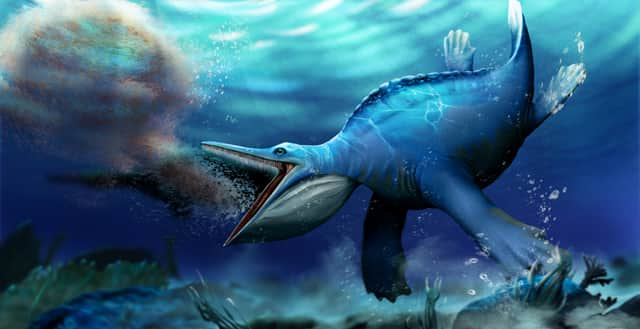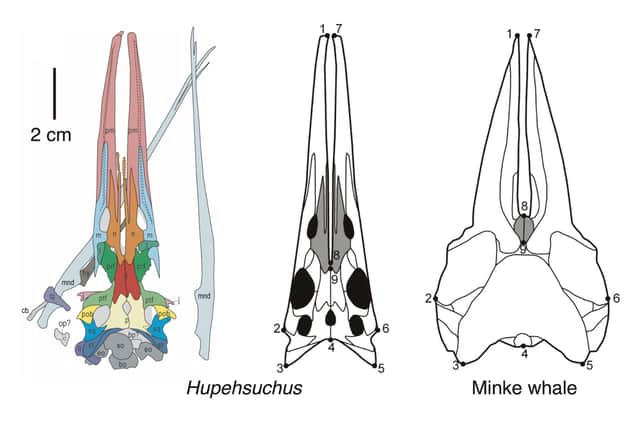Discovery made that links ancient marine reptiles from 250 million years ago to modern whales


A new discovery has linked marine reptiles from 250 million years ago to modern whales who roam the seas today. A new study reveals how the ancient animals were filter-feeding - just like many whales do today.
A remarkable new fossil, discovered in China, has allowed scientists to explore the long-extinct reptiles that once roamed our planet's oceans and found similarities to large whale species.
Advertisement
Hide AdAdvertisement
Hide AdA project between researchers from China and the UK discovered the Hupehsucian group of reptiles could expand their throats and filter food like modern-day whales.
The team also found the ancient animals' skulls had similar features to those of baleen whales - a group of 'whalebone whales' that sieve plankton from water, including blue and humpback whales.
The discovery has been hailed as providing insights into how creatures repopulated the planet following the largest known extinction event which had wiped out most lifeforms on Earth.


Hupehsuchus is an order of reptiles closely related to the ichthyosaurs - another large extinct marine mammal - which lived in the Early Triassic era.
Advertisement
Hide AdAdvertisement
Hide AdZichen Fang, from the Wuhan Center of China Geological Survey, led the research project
He said: "We were amazed to discover these adaptations in such an early marine reptile. The Hupehsuchians were a unique group in China, close relatives of the ichthyosaurs, and known for 50 years - but their mode of life was not fully understood."
Professor Michael Benton, a collaborator at the University of Bristol’s School of Earth Sciences, said the discovery sheds light on how the Earth repopulated after the end-Permian mass extinction event.
The event, which occurred around 251.9 million years ago, is known as the Great Dying and was Earth's most severe known extinction event.
Advertisement
Hide AdAdvertisement
Hide AdProf Benton added: "The Hupehsuchians lived in the Early Triassic, about 248m years ago, in China and they were part of a huge and rapid re-population of the oceans.
"This was a time of turmoil, only three million years after the huge end-Permian mass extinction which had wiped out most of life.
"It’s been amazing to discover how fast these large marine reptiles came on the scene and entirely changed marine ecosystems of the time."
Hupehsuchus - which had long tails and large, paddle-like limbs - were short-lived and only lasted a few million years in China during the late Olenekian age, which occurred between 251.2 and 247.2 years ago.
Advertisement
Hide AdAdvertisement
Hide AdThe researchers found details of the skull in the newly found fossils which indicate it had soft structures, such as an expanding throat which allowed them to engulf great masses of water containing shrimp-like prey.
The team also found Hupehsuchus skulls to show the same grooves and notches along the edges of its jaws similar to baleen whales, which have keratin strips instead of teeth.
Li Tian, another collaborator from the University of Geosciences Wuhan, added: “The other clue came in the teeth - or the absence of teeth.
"Modern baleen whales have no teeth, unlike toothed whales such as dolphins and orcas.
Advertisement
Hide AdAdvertisement
Hide Ad"Baleen whales have grooves along the jaws to support curtains of baleen, long thin strips of keratin, the protein that makes hair, feathers and fingernails.
"Hupehsuchus had just the same grooves and notches along the edges of its jaws, and we suggest it had independently evolved into some form of baleen."
Comment Guidelines
National World encourages reader discussion on our stories. User feedback, insights and back-and-forth exchanges add a rich layer of context to reporting. Please review our Community Guidelines before commenting.
